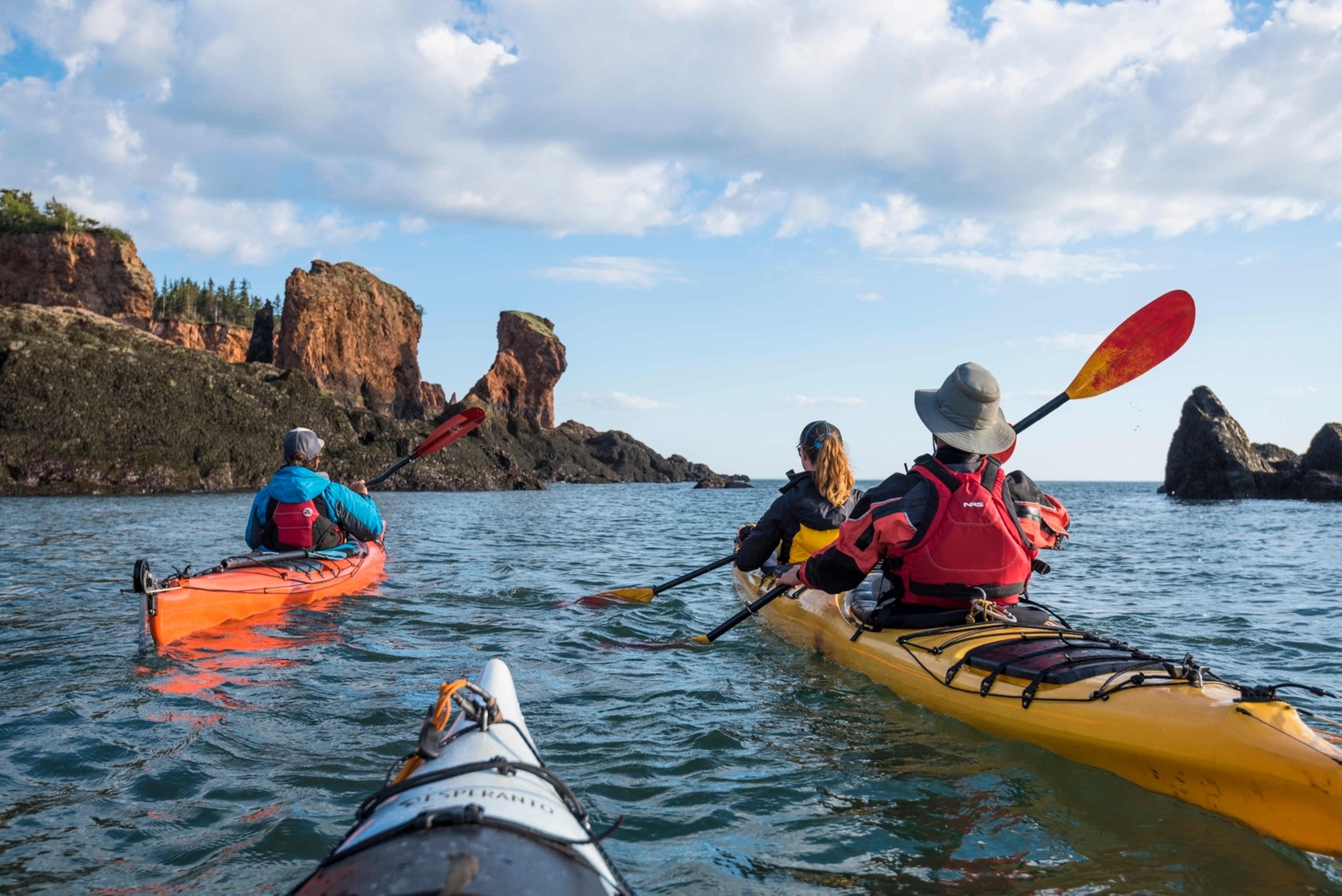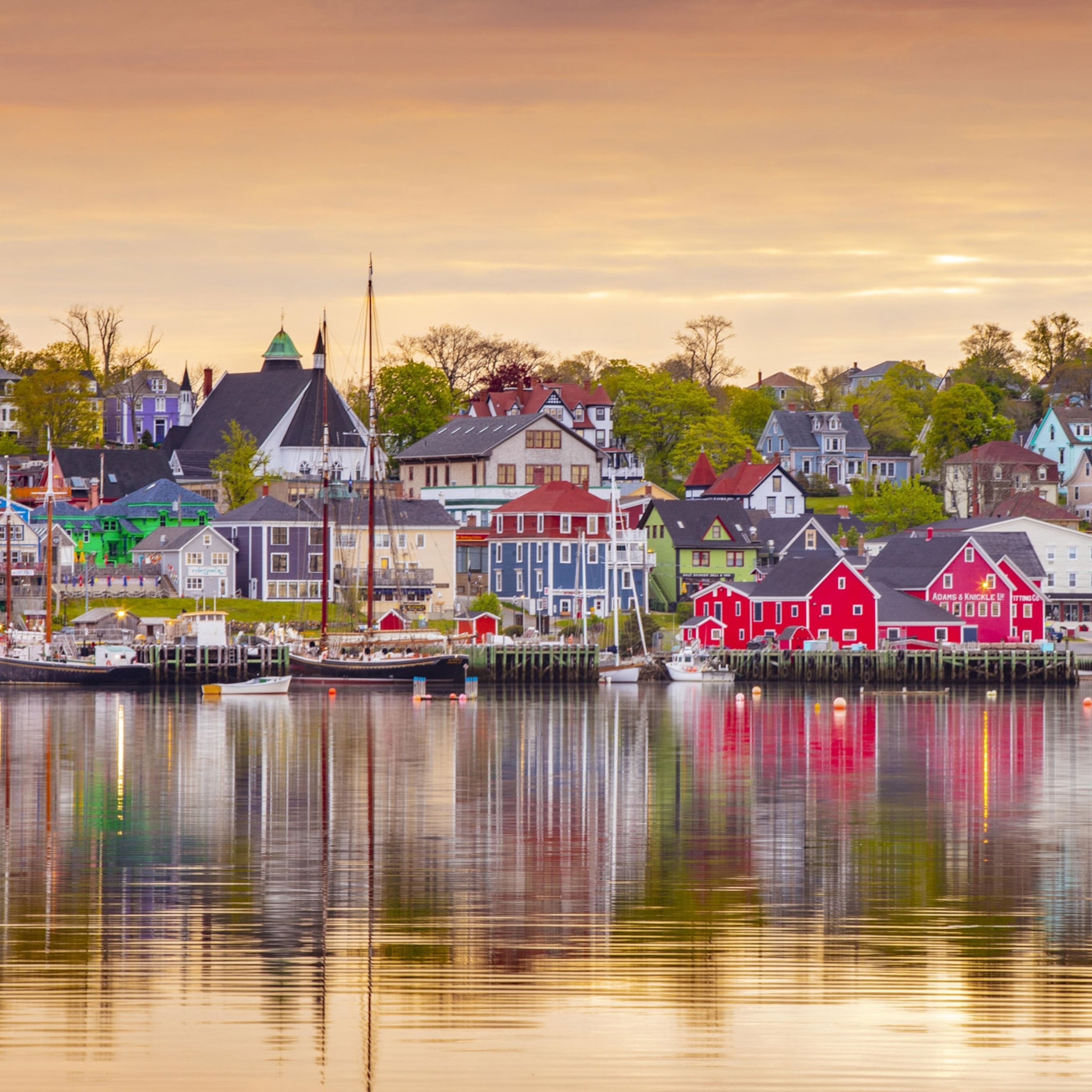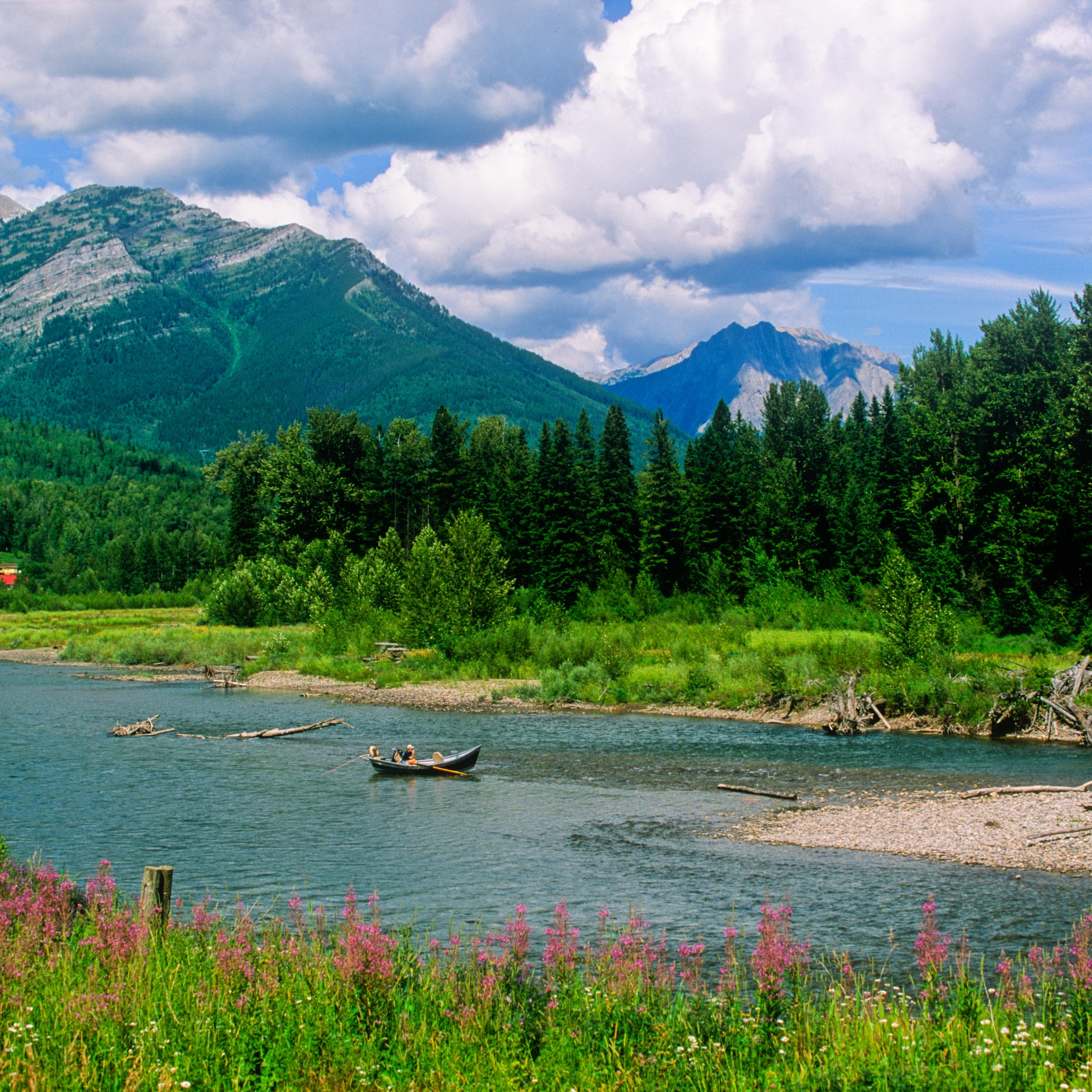Bay of Fundy Best Road Trip: Nova Scotia to New Brunswick
Experience the world’s highest tides from all angles on this incredible coastal adventure.
Embrace the full majesty of the Bay of Fundy and its surreal landscapes on an adventure-filled coastal drive with Nat Geo filmmaker and adventurer Bryan Smith. The eight-day trip around the bay begins in Halifax, Nova Scotia, ends in Moncton, New Brunswick, and offers twice-daily opportunities to witness over 150 billion tons of water surging in and out with the tides.
TOP FIVE REASONS TO GO
- Travel around the Bay of Fundy for the ultimate perspective on the world’s highest tides.
- Ride the wave of water created by the famous Fundy 50-foot tidal exchange.
- See whales, thousands of nesting puffins, and other wildlife.
- Walk across the ocean floor at low tide and go sea kayaking at high tide.
- Hike to historic lighthouses and clifftop overlooks.
DAY ONE: SHUBENACADIE RIVER AND ADVOCATE HARBOUR, NOVA SCOTIA
Ride the Tidal Bore
From Halifax, drive north to the Tidal Bore Rafting Resort for a rollicking Zodiac ride powered by the tidal bore, or wave of water, created by the surge of the incoming Fundy tide. Hold on tight as the churning waves rumble toward you, temporarily reversing the flow of the river, lifting the inflatable Zodiac, and launching you on a wet-and-wild rafting trip.
INSIDE TIP: The tidal bore is best at spring tides—occurring during new moons and full moons—when tides are strongest.
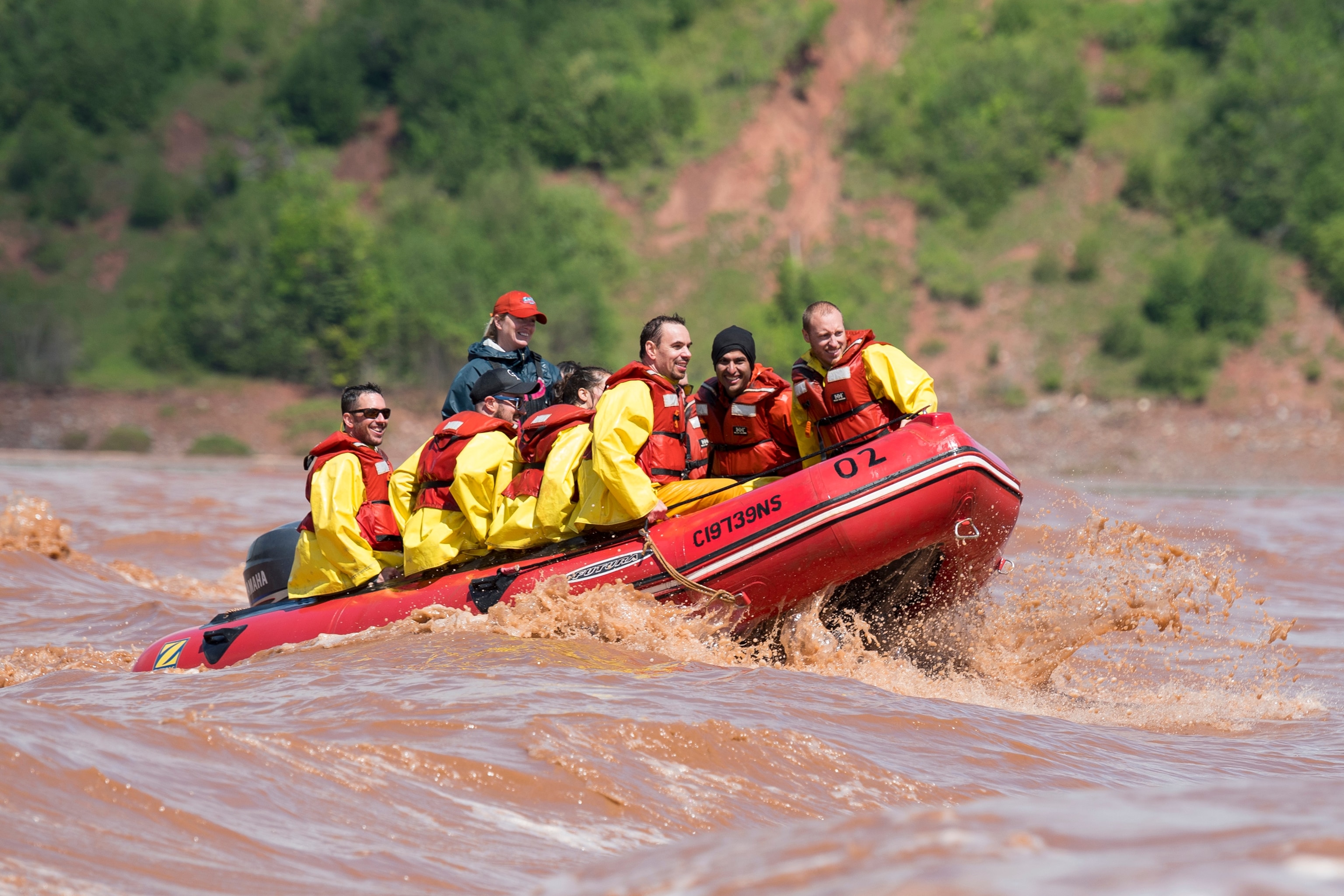
Feast on Fresh Halibut
Follow the Bay of Fundy coast north and west to the tiny hamlet of Advocate Harbour in time for dinner at The Wild Caraway Restaurant and Café. Hidden off-the-beaten path in a historic house overlooking the bay, the cozy restaurant (one of Nova Scotia’s best) serves dishes sourced from the surrounding water, woods, and fields. Try the grilled local halibut with sweet potato gratin, fiddleheads, daylily pesto, and daylily buds.
INSIDE TIP: Spend the night and take a sunset stroll on the beach at the Driftwood Park Retreat.
DAY TWO: CAPE CHIGNECTO, NOVA SCOTIA
Paddle Among Rock Stars
Just up the coast from Advocate Harbour, see some of the Bay of Fundy’s most iconic geological formations on a sea kayaking trip at Cape Chignecto Provincial Park, part of the Cliffs of Fundy Aspiring Geopark. Choose the NovaShores Adventures high-tide tour to paddle close to the towering cliffs and around the famous Three Sisters sea stacks, or the low-tide tour to see more exposed rock features. After kayaking, retrace part of your route, looping south around the bay to spend the night in Wolfville.
INSIDE TIP: If your schedule allows, do the two-day, Seal Cove kayaking adventure with NovaShores Adventures. Camping out on the beach is the ultimate way to witness the 50-foot tides.
DAY THREE: CAPE SPLIT, HALL'S HARBOUR, AND DIGBY,
NOVA SCOTIA
Hike to Edge-of-the-World Views
Plan to spend at least five hours hiking the backcountry trail at Cape Split Provincial Park Reserve. The eight-mile (round-trip) hike leads through the woods and out to a 200-foot-high viewpoint overlooking the Bay of Fundy. Sit on the grass (well back from the edge of the cliffs) to watch 150 billion tons of water rush through the rocks below and experience the sensation of being on the edge of civilization.
INSIDE TIP: For the best photos, take this hike late in the afternoon as the sun starts to fall over the New Brunswick side. The Cape faces west, so all the birds on the rocks will be backlit, the cliffs will be side-lit, and the water takes on a unique blue color.
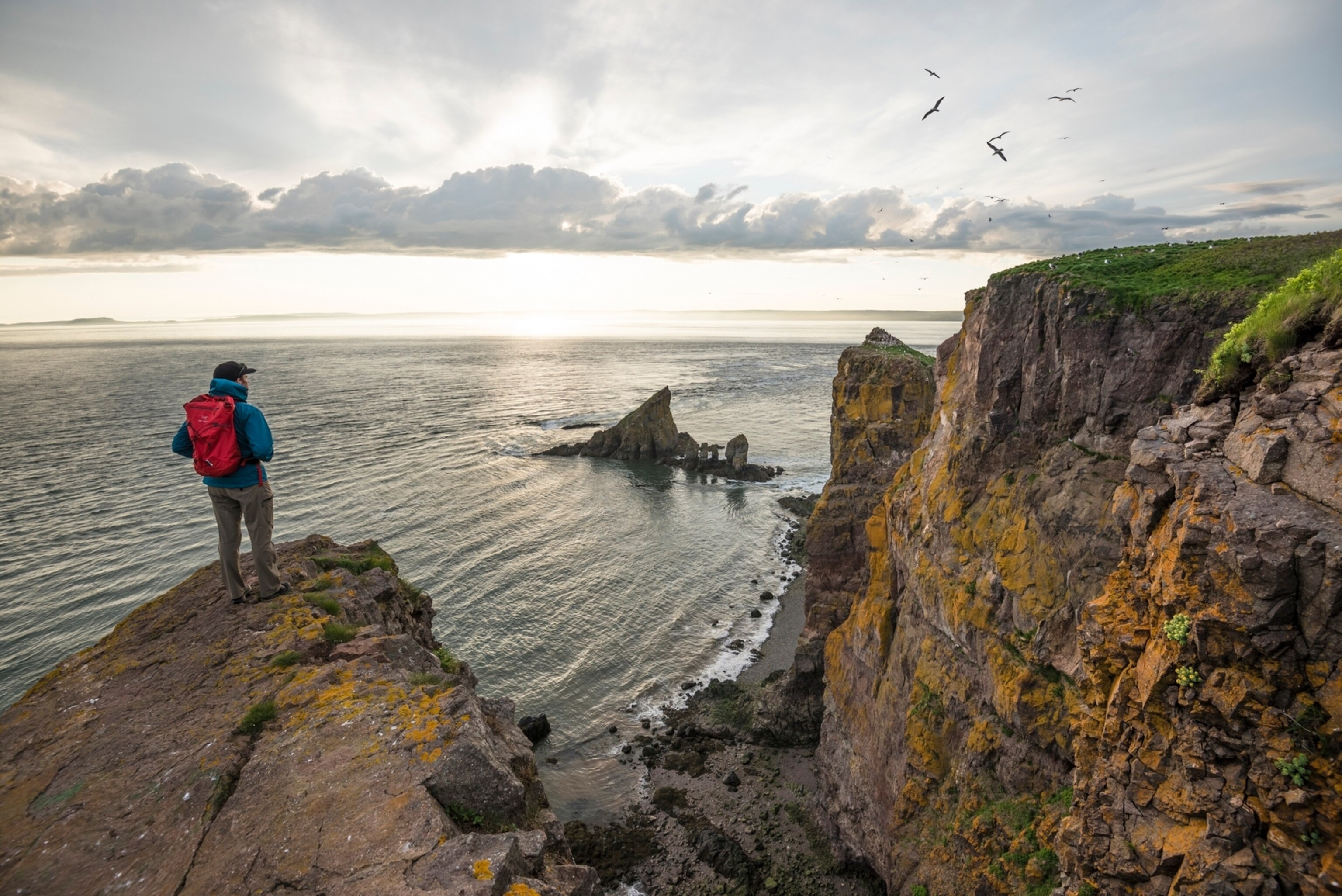
Eat Fresh Lobster and Scallops
Continue south along the bay to Hall’s Harbour Lobster Pound. In addition to fresh lobster and house specialties like Lobster Poutine (fries topped with lobster cream sauce, lobster, and cheese curds), the restaurant is one of the best places to watch the twice-daily tidal exchange. If possible, arrive just before high tide to see the harbor rapidly refill with water, lifting the lobster boats that were grounded in the mud. Spend the night in Digby, and make dinner reservations to try the world-famous Digby Scallops at Churchill’s Restaurant and Lounge at Digby Pines Golf Resort.
DAY FOUR: BRIER ISLAND, NOVA SCOTIA
Go Whale Watching
Getting to the next stop, Brier Island, is part of the adventure. The 90-minute drive west from Digby includes two quick ferry rides. Ferries run hourly (the first on the half hour and the second on the hour) 24/7 and the schedule is coordinated to limit wait times. Mid-May to mid-October, Brier Island offers some to the best whale watching in the bay. Before your trip, book a Brier Island Whale and Seabird Cruise to spot humpbacks, finbacks, and the gigantic North Atlantic Right Whale.
Hike to a Lighthouse
Brier Island is laced with winding dirt roads and meandering hiking trails leading along the coast, through meadows and forests, and onto the beach. Trails connect to, or within easy viewing distance of, three historic lighthouses: Peter Island; North Light; and Western Light, the octagonal lighthouse marking the entrance to the Bay of Fundy. After hiking, drive back to Digby, take the ferry across the Bay of Fundy to Saint John, New Brunswick.
INSIDE TIP: Western Light is the most westerly aspect of Nova Scotia. Plan to be there at sunset to capture the classic candy cane-style lighthouse of the Maritimes and take home an iconic image.
DAY FIVE: SAINT JOHN AND GRAND MANAN,
NEW BRUNSWICK
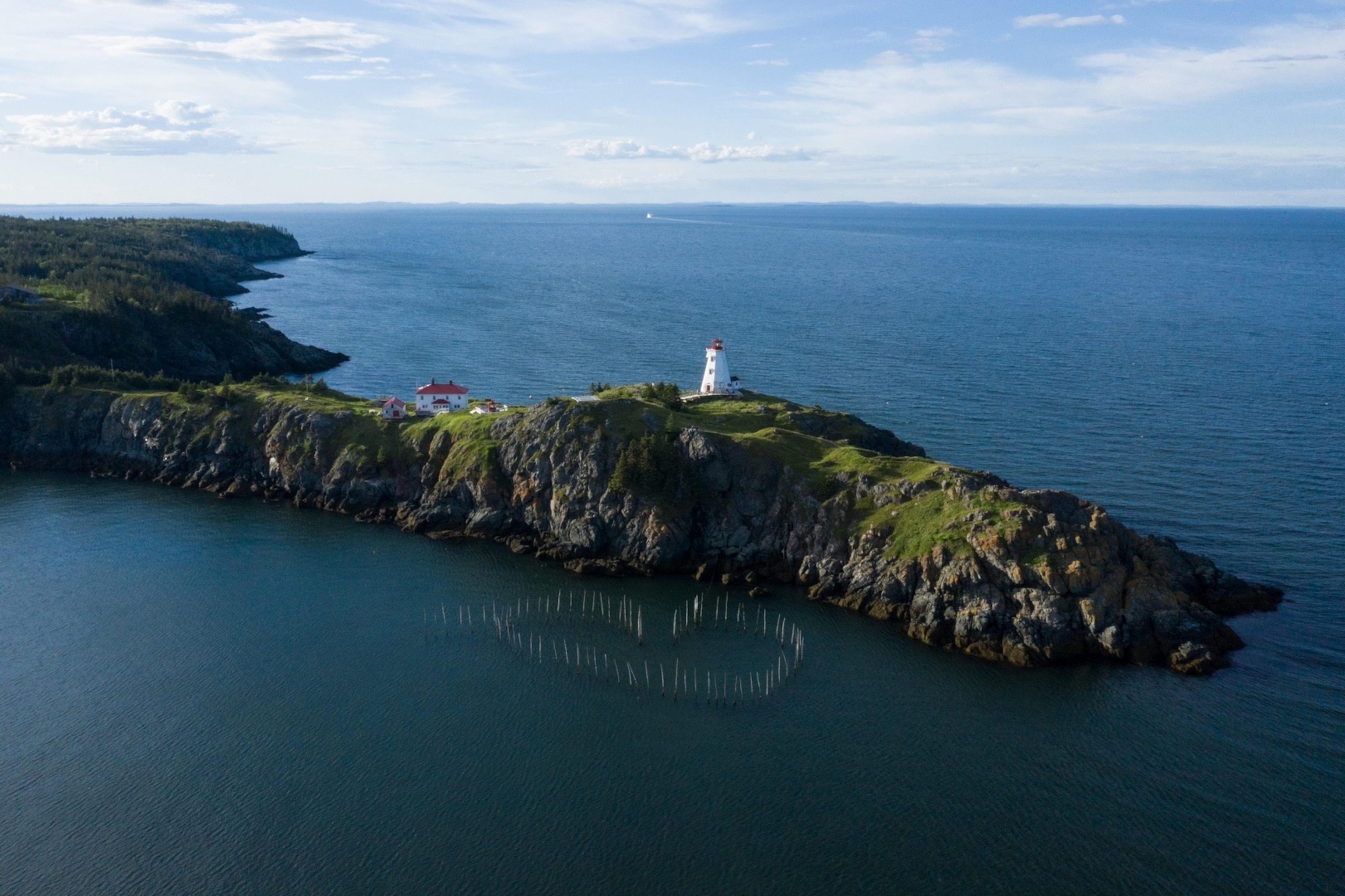
Stay on a Wild Island
From Saint John, take the coastal route 44 miles southwest to Blacks Harbour and catch the ferry to Grand Manan Island. Spend two nights on the unspoiled island to experience a smorgasbord of Bay of Fundy experiences, such as coastal biking and hiking, sea kayaking, beach combing, and whale watching (often on the ferry ride to and from Blacks Harbour).
INSIDE TIP: The western side of Grand Manan is incredibly wild. To truly experience the coastline, go sea kayaking with Adventure High or watch for whales from the Swallow Tail Lighthouse.
DAY SIX: GRAND MANAN AND MACHIAS SEAL ISLAND,
NEW BRUNSWICK
Photograph Nesting Puffins
The ultimate Grand Manan adventure is seeing thousands of nesting puffins and other sea birds on Machias Seal Island. Sea Watch Tours is the exclusive Canadian operator for the daily (late June to late July) trips, which are limited to 15 people and sell out months in advance. Choose the “going ashore” for up-close views of the puffins.
INSIDE TIP: On the land tour, you’re in an enclosed blind only 10 feet away from the puffins, so don’t take too big of a lens for photographs. Even a smartphone will capture incredible images.
DAY SEVEN: ST. MARTINS, NEW BRUNSWICK
Take a Cliff-Hugging Drive
Before catching the ferry back to Blacks Harbour, stop nearby at The Old Wellhouse Café, arguably one of the Bay of Fundy’s best coffee shops. On the mainland, drive east to St. Martins, gateway to The Fundy Trail, a 6,323-acre coastal wilderness park. Wind along coastal cliffs on the 19-mile Fundy Trail Parkway to watch the tides and access paths to waterfalls, beaches, and a suspension bridge.
Explore Sea Caves
In St. Martins, the world’s highest tides create the rare opportunity to explore sea caves on foot and on the water. Check the tide chart to plan a low-tide walk out to the caves, allowing plenty of time to return to shore before the water rises. At high tide, float into the caves on a Red Rock Adventure sea kayaking trip.
INSIDE TIP: Neighboring St. Martins' restaurants The Caves and Seaside engage in a friendly competition for “world’s best” seafood chowder honors. Decide for yourself by trying a steaming cup of chowder (made with fresh-from-the-Bay seafood) from each restaurant.
DAY EIGHT: FUNDY NATIONAL PARK AND THE HOPEWELL ROCKS, NEW BRUNSWICK


Stargaze in a Dark Sky Preserve
Cap off your Bay of Fundy adventure by hiking, kayaking, mountain biking, and experiencing the world’s highest tides at Fundy National Park. Offering a best-of-the-bay experience, the coastal wilderness park is a Dark Sky Preserve, meaning the stargazing is amazing on clear, moonless nights. Spend more time in the park by camping – without lugging your own tent – in an oTENTik (a hybrid tent-rustic cabin), yurt, or no-frills cabin.

See Surreal Rock Formations
Plan to spend time exploring the crown jewel of New Brunswick’s Bay of Fundy coast: The Hopewell Rocks. Located only 30 miles south of the airport in Moncton, the geologic wonderland was created millions of years ago and is continually reshaped by the elements and tides. Walk across the ocean floor – accessible for three hours before and until three hours after low tide – for up-close views of otherworldly sandstone formations, such as the renowned Flowerpot Rocks.
INSIDE TIP: For photos, try to be here at both a low tide and sunset to find angles looking back through the sea stacks and get those iconic lens flares. High tide is all about sunrise, low tide is all about sunset.
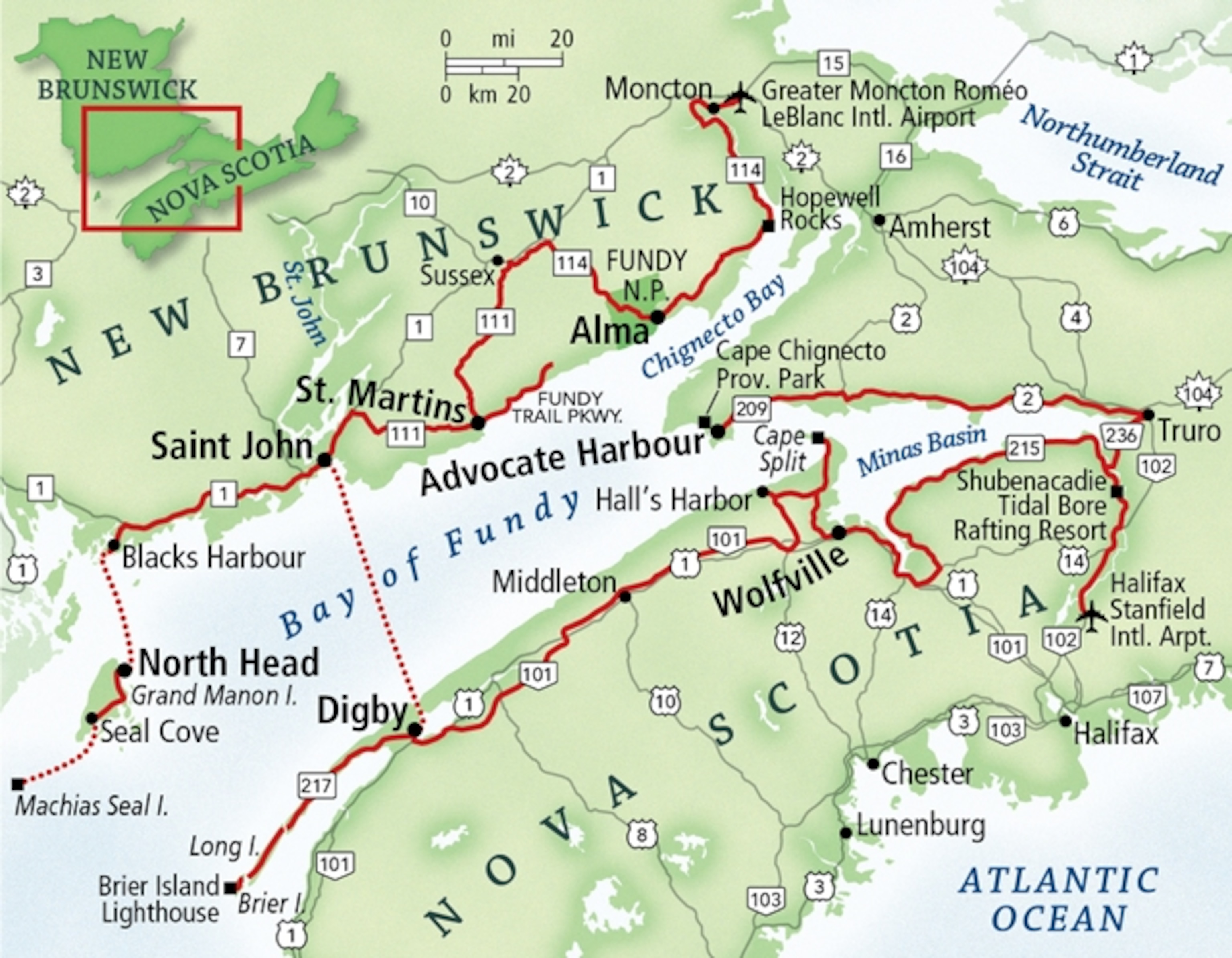
HOW TO TAKE THIS TRIP
The drive goes around a wide swath of the 170-mile-long Bay of Fundy, the Atlantic Ocean inlet bordered by New Brunswick (to the north and west) and Nova Scotia (to the south and east). While this itinerary starts in Halifax, Nova Scotia, and ends in Moncton, New Brunswick, you can drive the route in reverse, beginning in Moncton. Whatever direction you choose, you’ll travel between the two provinces by crossing the Bay of Fundy aboard a passenger vehicle ferry.
WHERE TO STAY
Spend the first night overlooking the bay in Advocate Harbour at the Driftwood Park Retreat. If you don’t beach-camp the second night on the Seal Cove Adventure, stay in Wolfville at the historic Blomidon Inn. In Digby, overnight at Digby Pines Golf Resort and Spa. In Saint John, lodging options range from no-frills camping to boutique hotels. Spend two nights on Grand Manan at the Inn at Whale Cove Cottages. In St. Martins, stay at the Salmon River B&B. If you’re not camping in Fundy National Park, stay nearby in a charming Alma bed and breakfast.
TRAVEL TIP: June to September is the best time to make the trip, since some restaurants, attractions, and inns may be closed or have limited hours during the offseason. July to August is peak whale-watching season.
